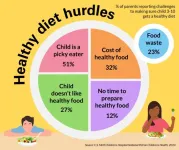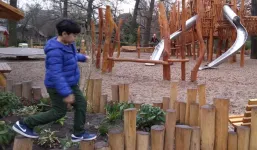(Press-News.org) The SARS-CoV-2 virus that causes COVID has the unsettling ability of often generating variants of itself. Other viruses also mutate, but as SARS-CoV-2 quickly spread throughout the entire human population during the pandemic, killing millions, the virus’ dynamic evolution posed a serious problem: it repeatedly challenged our bodies’ immune response fighting the virus and hindered the process of getting updated vaccines ready.
Understanding the genetic mechanism fueling SARS-CoV-2’s ability to generate variants can go a long way in keeping COVID at bay. In this study published in Nature Microbiology, researchers at Baylor College of Medicine and collaborating institutions developed a new technology called tARC-seq that revealed a genetic mechanism affecting SARS-CoV-2 divergence and enabled the team to calculate SARS-CoV-2’s mutation rate. Using tARC-seq, the researchers also captured new mutations in SARS-CoV-2 in infected cells in the lab that recapitulated observations revealed by worldwide pandemic viral sequencing data. The findings can be useful for monitoring viral evolution in the human population.
“The SARS-CoV-2 virus uses RNA, instead of DNA, to store its genetic information. Our lab has long been interested in studying RNA biology, and when SARS-CoV-2 emerged we decided to investigate its process of RNA replication, which is typically error prone in RNA viruses,” said corresponding author Dr. Christophe Herman, professor of molecular and human genetics and of molecular virology and microbiology at Baylor.
The researchers wanted to follow RNA replication errors because they are crucial for understanding how the virus evolves, how it changes and adapts as it spreads in the human population, but current methods lacked the precision to detect rare new SARS-CoV-2 mutations, particularly in samples with a low number of viruses, such as those from patients.
“Because samples from patients have very few SARS-CoV-2 RNA copies, it is difficult to distinguish between the errors made by SARS-CoV-2 RNA-dependent RNA polymerase (RdRp), the enzyme that makes copies this virus’ RNA, and the errors from the other enzymes used in the sequence analysis,” said Herman, a member of the Dan L Duncan Comprehensive Cancer Center. “We have developed a technique that we call Targeted Accurate RNA Consensus sequencing (tARC-seq), which allows us to measure true errors when copying specific RNA present in very low amounts.”
A new perspective on the drivers of SARS-CoV-2 variant diversity
Originally, the thought was that, because SARS-CoV-2 has an internal mechanism to repair the mistakes RdRp makes, then the virus should not evolve or mutate very quickly.
“This idea contrasted with the fact that during the pandemic new COVID variants emerged often around the world,” Herman said. “Since the pandemic began, we've seen a number of prominent variants, including Alpha, Beta, Delta and Omicron, as well as variants within these groups.”
With their improved analytical tool in hand, Herman and his colleagues accurately determined the mutation frequency of SARS-CoV-2 and types of mutations, both in cell cultures in the lab and clinical samples. “We found that the mutation rate was higher than originally expected and this helps explain the frequent appearance of COVID variants,” Herman said.
They also discovered that there are hotspots in SARS-CoV-2 RNA, locations that are more prone to mutation than others. “For example, we identified a hotspot on the RNA region corresponding to the spike protein, the protein that allows the virus to invade cells. Also, RNA of the spike protein makes up many vaccines,” Herman said.
The tARC-seq method also revealed that the generation of new variants involved template switching. “We determined that, as RdRp is copying one RNA template or sequence, it jumps to another template on a nearby virus and then continues copying the RNA, so the resulting new RNA copy is a mixture of both RNA templates,” Herman said. “This template switching will result in sequence insertions or deletions that bring about viral variability. We also observed complex mutations. SARS-CoV-2 takes advantage of these two powerful biological mechanisms, template switching and complex mutations, that allow it to evolve quickly, generating variants to adapt to and persevere in human populations.”
“It was interesting and exciting to see that tARC-seq allowed us to capture in laboratory cell cultures the emergence of new mutations that recapitulate the mutations observed with worldwide pandemic sequencing data,” Herman said. “Our new technology captures a snapshot of new mutations in clinical samples from individual patients and can be useful for monitoring viral evolution in the human population.”
First author Catherine C. Bradley, Chen Wang, Alasdair J.E. Gordon, Alice X. Wen, Pamela N. Luna, Matthew B. Cooke, Brendan F. Kohrn, Scott R. Kennedy, Vasanthi Avadhanula, Pedro A. Piedra, Olivier Lichtarge, Chad A. Shaw and Shannon E. Ronca are contributors to this work. The authors are affiliated with one or more of the following institutions: Baylor College of Medicine, University of Washington and Texas Children’s Hospital.
The study was supported by National Institutes of Health grants R01GM088653, 3R01AG061105-03S1, 1R21CA259780 and 1R21HG011229, and by National Science Foundation grant DBI-2032904.
###
END
New technology uncovers mechanism affecting generation of new COVID variants
2024-04-22
ELSE PRESS RELEASES FROM THIS DATE:
Planning at multiple scales for healthy corals and communities
2024-04-22
Governments in the Mesoamerican Reef region are exploring the use of nature-based solutions to strengthen coral health and societal benefits for coastal communities. A new study led by Stanford researchers in collaboration with scientists from the World Wildlife Fund, the Healthy Reefs Initiative, and others from the Smart Coasts project quantified the outcomes of different watershed interventions to support coral health at regional versus national scales, and identified target areas that could improve both ecosystem and societal benefits nationally and across the region.
The nature-based approaches evaluated as key ...
U of T researchers map protein network dynamics during cell division
2024-04-22
An international team led by researchers at the University of Toronto has mapped the movement of proteins encoded by the yeast genome throughout its cell cycle. This is the first time that all the proteins of an organism have been tracked across the cell cycle, which required a combination of deep learning and high-throughput microscopy.
The team applied two convolutional neural networks, or algorithms, called DeepLoc and CycleNet, to analyze images of millions of live yeast cells. The result was a comprehensive map identifying where proteins are located and how they move and change in abundance ...
Pressure in the womb may influence facial development
2024-04-22
Physical cues in the womb, and not just genetics, influence the normal development of neural crest cells, the embryonic stem cells that form facial features, finds a new study led by UCL researchers.
The study published in Nature Cell Biology found that an increase in hydrostatic pressure sensed by the embryo can hinder the healthy development of facial features in mouse and frog embryos and in human embryoids (cell structures grown in the lab from human stem cells), suggesting that differences in pressure might affect the risk of facial malformations.
The ...
AI weather forecasts captured Ciaran’s destructive path
2024-04-22
Artificial intelligence (AI) can quickly and accurately predict the path and intensity of major storms, a new study has demonstrated.
The research, based on an analysis of November 2023’s Storm Ciaran, suggests weather forecasts that use machine learning can produce predictions of similar accuracy to traditional forecasts faster, cheaper, and using less computational power.
Published in npj Climate and Atmospheric Science, the University of Reading study highlights the rapid progress and transformative potential of AI in weather prediction.
Professor Andrew Charlton-Perez, ...
Feedback loop that is melting ice shelves in West Antarctica revealed
2024-04-22
Feedback loop that is melting ice shelves in West Antarctica revealed
New research has uncovered a feedback loop that may be accelerating the melting of the floating portions of the West Antarctic Ice Sheet, pushing up global sea levels.
The study, published in Science Advances, sheds new light on the mechanisms driving the melting of ice shelves beneath the surface of the ocean, which have been unclear until now.
The West Antarctic Ice Sheet has been losing mass in recent decades, contributing to global sea level rise. If it were to melt entirely, global sea levels would rise by around five meters.
It’s known that Circumpolar Deep Water (CDW), ...
How does aspirin help prevent colorectal cancer development and progression?
2024-04-22
Long-term daily use of aspirin can help to prevent the development and progression of colorectal cancer, but the mechanisms involved have been unclear. New research has revealed that aspirin may exert these protective effects by boosting certain aspects of the body’s immune response against cancer cells. The findings are published by Wiley online in CANCER, a peer-reviewed journal of the American Cancer Society.
To investigate the effects of aspirin (a nonsteroidal anti-inflammatory drug) on colorectal cancer, investigators in Italy obtained tissue samples from 238 patients who underwent surgery for colorectal cancer in 2015–2019, 12% of whom were aspirin ...
3 in 5 parents play short order cook for young children who don’t like family meal
2024-04-22
While most parents of preschool and elementary aged children strive to give their children a balanced, nutritional diet, some of their strategies to promote healthy eating may backfire, a national poll suggests.
A top example from the report: Three in five parents customize meals if their child doesn’t like what everyone else is eating.
Meanwhile, one in eight parents require children to eat everything on their plate, according to the University of Michigan Health C.S. Mott Children’s Hospital National Poll on Children’s Health. And while just one in three believe the standard American diet is healthy for kids, few have tried alternative, potentially more nutritional ...
Japan’s premodern concept of nature at root of distinctive mindset in early childhood education
2024-04-22
Osaka, Japan — Observers of Japanese early childhood education and care have pointed to the mindset of educators watching over and waiting on preschoolers as being an intriguing tendency. This mimamoru approach has its roots in a premodern concept of nature, according to Professor Yosuke Hirota at the Graduate School of Literature and Human Sciences of Osaka Metropolitan University.
Professor Hirota looked into the works of Sozo Kurahashi (1882-1955) and Kitaro Nishida (1870-1945) to see how this concept of nature from the past made its way into education in the present day. Kurahashi’s writing on ...
First Nations patients leave ED without completing treatment more than comparable non–First Nations patients
2024-04-22
First Nations patients in Alberta leave emergency departments (EDs) without completing treatment more often than comparable non–First Nations patients, due in part to anti-Indigenous racism expressed by providers, found new research published in CMAJ (Canadian Medical Association Journal) https://www.cmaj.ca/lookup/doi/10.1503/cmaj.231019.
Higher proportions of incomplete ED care for First Nations patients compared with non–First Nations patients occurred even in cases of serious diagnosis, and were found across all parts of Alberta. Provincially, 6.8% of First Nations visits end without completing ...
What do you know about measles and vaccination?
2024-04-22
With measles cases rising in Canada and internationally, it is important for clinicians to understand the disease and the role of vaccination against measles. Two practice articles in CMAJ (Canadian Medical Association Journal) https://www.cmaj.ca/lookup/doi/10.1503/cmaj.240415 https://www.cmaj.ca/lookup/doi/10.1503/cmaj.240371
provide succinct overviews of this highly infectious disease. Many clinicians may not have direct experience with measles diagnosis and treatment as Canada achieved measles elimination status in 1998.
“The increase in measles activity globally and in Canada is a reminder of the importance of immunization. ...


